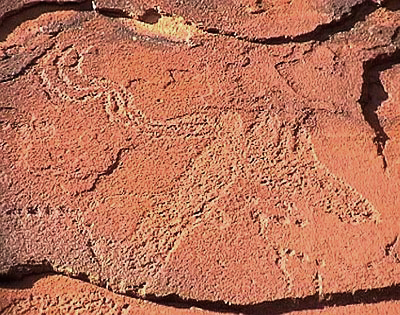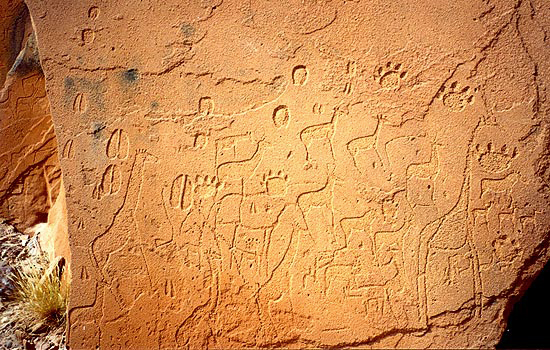 |
 |
TWYFELFONTEIN CUPULES |
2/8 |
To avoid confusion, it is urgently needed to clearly define the term "cupules" and simultaneously to limit the subject matter, as not every cultural depression in a rock surface should be regarded as rock art. In the discussion about cupule engravings from Jinmium, northern Australia, Taçon, Fullagar, Ouzman & Mulvaney offer useful information to identify the cupule. A true cupule can be defined as a cup-shaped, non-utilitarian and definitely cultural mark that has been pecked or pounded into a rock surface (1997: 943). In general the cupule must be admitted as (an element of) rock-art. Although a true cupule never has been formed by nature, it is possible and even likely that, in many places around the world, natural hollows have triggered the execution of anthropic (cultural) depressions (ibid. 1997: 961).
However, cupules (averaging 5cm in diameter) are not to be confused with grinding hollows that are often much larger (they may range from 8 cm to over 30cm in diameter). Grinding hollows are abrasion-formed or improved (natural or cultural) depressions used for processing food, dyes or other material, whereas the meaning of cupules is often obscure. Although many grinding hollows are circular and deep like large cupules, also shallow and elongated depressions occur. Grinding hollows are not necessarily deeper than cupules. Another distinction is that cupules may appear on horizontal, steeply sloping and vertical surfaces, whereas grinding hollows almost exclusively are found on rock surfaces that are horizontal or nearly so.
There are however, more cultural cupule-like depressions that should not be regarded as rock-art. In many parts of Africa there are found rows of small depressions executed in stone or wood that are part of a board game (Blauer 1999: 45). It is known under many names, for instance as Mafuvha in the tshiVenda language of northern South Africa. The board game is sometimes associated with rock-art sites, like at Kaoxa's Shelter in the north of South Africa (Eastwood, Ouzman & MacWhirter. 2000: 5). Also in Namibia there are scattered throughout the country many flat rock outcrops bearing large concentrations of cultural depressions, the majority of which have been arranged in four parallel rows to serve as a board for that specific African game. Many concentrate around Windhoek (Site 7 in
Figure 1). Although some examples have been reported by Scherz at two rock-art sites some 40 km WNW of Twyfelfontein (Sites 15 and 16 in
Figure 3), no such game-boards have ever been recorded in the Twyfelfontein area (see also the description of Sites 2.1 and 2.2 at Twyfelfontein, further down). The "cupules" used for playing this specific game are also excluded from this survey.
The definition of cupules also excludes the cultural depressions frequently found at resounding rocks. These are often large stones, called lithophones or, especially in southern Africa, gong rocks, which produce a percussive metallic sound when touched or hammered with a pebble or even with the hand (Ouzman 2001b: 240). Some lithophones even have a number of anthropic depressions that produce different tones. SE of Twyfelfontein, several lithophones have been reported around Site 6 in
Figure 1 (Scherz 1975), but neither at Twyfelfontein itself, nor in its immediate surroundings true gong rocks are known to exist. However, several of the sandstone rocks at Twyfelfontein, especially the harder rock types that have been incompletely fractured, produce a deep resounding effect when hit, even with the bare flat hand (e. g. stones NW of Site 4.9).
What also should be excluded as cupules are the (very) small depressions produced by pecking. This distinction presents a problem, as in several instances these peck marks are rather large and sometimes small clusters of peck marks make up a design, like an oval of mostly triangular but irregular pecked marks at a rock-art site SE of Twyfelfontein (Site 17 in
Figure 2 and
Figure 3). Also at Twyfelfontein, especially at Site 1.1 (
Figure 6), the distinction between (clusters of) peck marks, small cupules, standard cupules and even natural depressions is notoriously difficult.
Other small depressions often form an integral part of engravings of animal spoor (
Figure 89) and human feet (
Figure 85) and also of a design that has been called "phallus" by Scherz. The "phallus"-design consists of a vertical groove adjoined near its lower end by two small, often oval shaped depressions (an example can be seen below the rows of dots in
Figure 7). All those cupule-shaped depressions, of which many examples exist at Twyfelfontein, are excluded from the statistics of this survey. However, there are some instances where cupules are associated with spoor, without forming a biological part of the animal. Such depressions are included as true cupules.
In order to describe the cupules occurring at Twyfelfontein efficiently, a typology would be useful. This immediately presents a problem, because it proved to be impossible to construct a typology in which every cultural depression is neatly classified. Not only there are many doubtful cases, but also the varying contexts will yield different results. Disregarding dubious instances, my general typology uses a notation for type and a notation for size. The following types may be recognised, in which types 3, 4 and 5 are regarded as true cupules in this survey (see also Table 1). Finally, it must be emphasised that the numbers of cupules presented in this survey have the status of an interim report, as the numbers undoubtedly will change because of new finds in the future.
| R |
Randomly distributed across the panel |
1: point |
< 01 mm |
| A |
Arranged in patterns, for instance rows |
2: dot |
< 05 mm |
| Z |
Associated with zoomorphic engravings |
3: small cupule |
< 30 mm |
| G |
Associated with geometric engravings |
4: standard cup |
< 50 mm |
| C |
Superimposed upon iconic designs |
5: large cupule |
< 50 mm |
| I |
Superimposed by iconic desIgns |
6: basin |
< 10 mm |
→
A Survey into the Relationship between
Animal-Engravings & Cupules
→
The Rock Art of Twyfelfontein
→
The Rock Art of Namibia
→
The African Rock Art Archive
→
Bradshaw Foundation
Like us on Facebook & Follow us on Twitter to receive news & updates:










